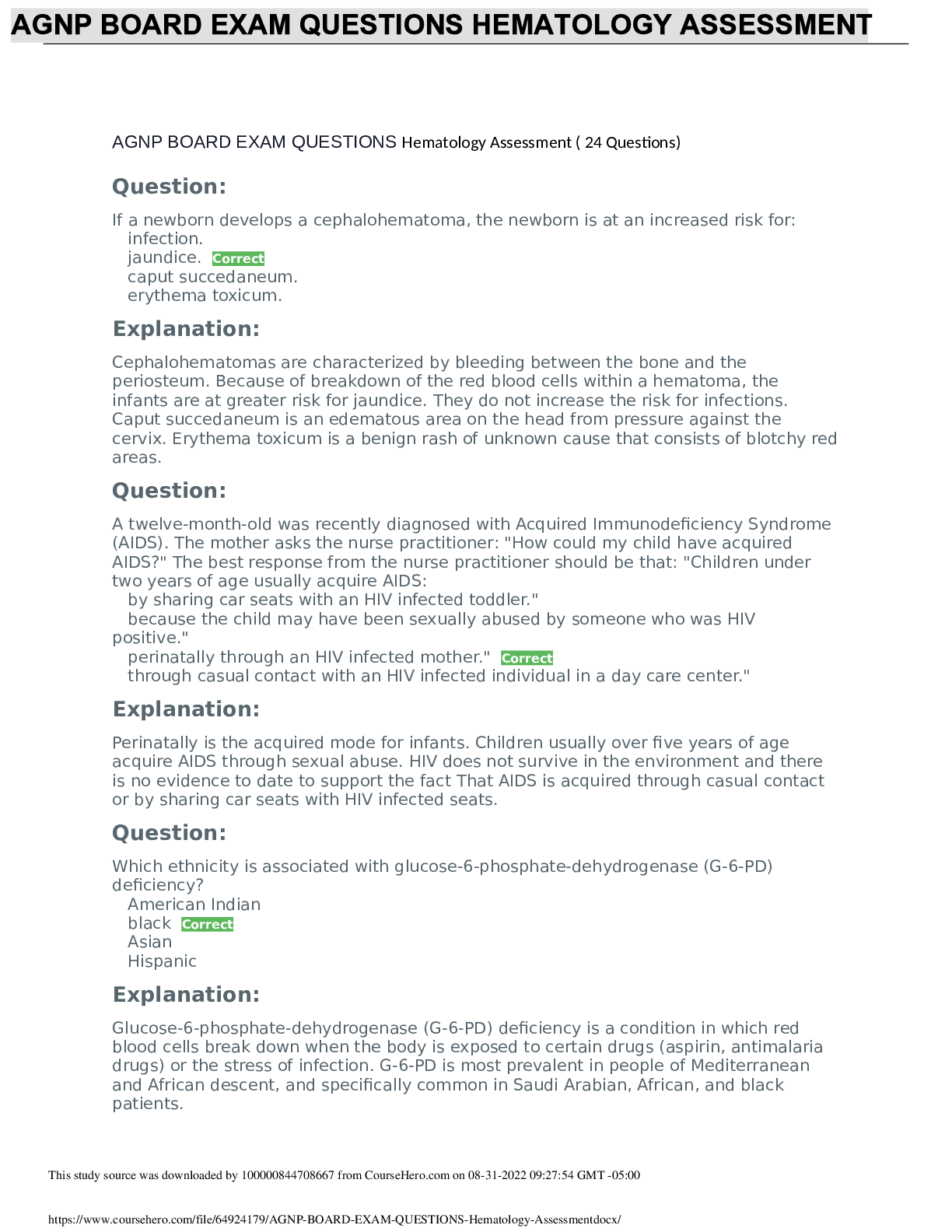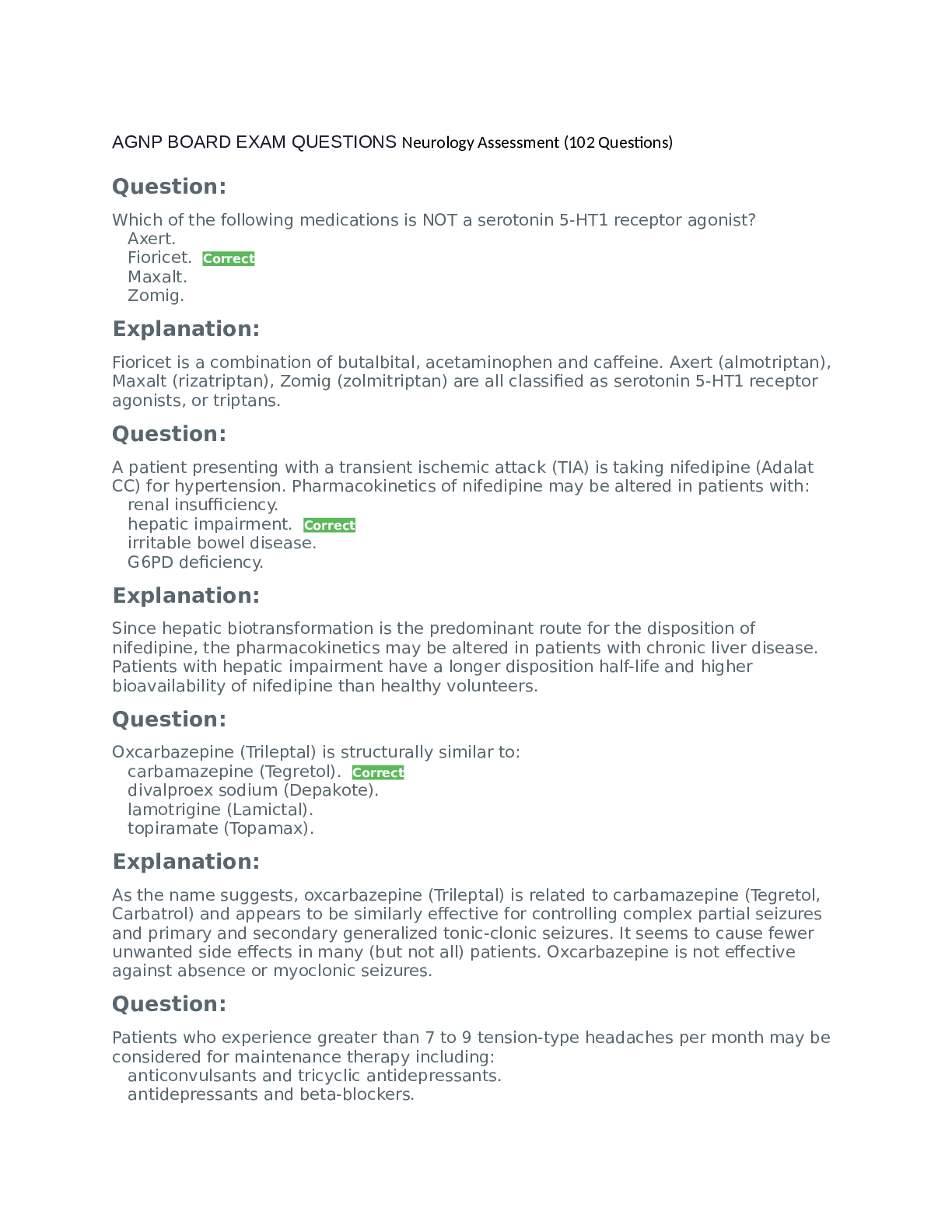NURS 300 Exam 3 Quizlet( Complete Solution Rated A)
Document Content and Description Below
NURS 300 Exam 3 Quizlet Chapter 32 1. A nurse is teaching a patient about medications. Which statement from the patient indicates teaching is effective? a. "My parenteral medication must be taken... with food." b. "I will rotate the sites in my left leg when I give my insulin." c. "Once I start feeling better, I will stop taking my antibiotic." d. "If I am 30 minutes late taking my medication, I should skip that dose." 2. A nurse is preparing to administer an injection to a patient. Which statement made by the patient is an indication for the nurse to use the Z-track method? a. "I am allergic to many medications." b. "I'm really afraid that a big needle will hurt." c. "The last shot like that turned my skin colors." d. "My legs are too obese for the needle to go through." 3. A 2-year-old child is ordered to have eardrops daily. Which action will the nurse take? a. Pull the auricle down and back to straighten the ear canal. b. Pull the auricle upward and outward to straighten the ear canal. c. Sit the child up for 2 to 3 minutes after instilling drops in ear canal. d. Sit the child up to insert the cotton ball into the innermost ear canal. 4. A patient has an order to receive 0.3 mL of U-500 insulin. Which syringe will the nurse obtain to administer the medication? a. 3-mL syringe b. U-100 syringe c. Needleless syringe d. Tuberculin syringe 5. A patient has an order to receive 12.5 mg of hydrochlorothiazide. The nurse has on hand a 25 mg tablet of hydrochlorothiazide. How many tablet(s) will the nurse administer? a. 1/2 tablet b. 1 tablet c. 1 1/2 tablets d. 2 tablets 6. The patient is to receive phenytoin (Dilantin) at 0900. When will be the ideal time for the nurse to schedule a trough level? a. 0800 b. 0830 c. 0900 d. 0930 7. A patient is receiving vancomycin. Which function is the priority for the nurses to assess? a. Vision b. Hearing c. Heart tones d. Bowel sounds 8. A health care provider orders lorazepam (Ativan) 1 mg orally 2 times a day. The dose available is 0.5 mg per tablet. How many tablet(s) will the nurse administer for each dose? a. 1 b. 2 c. 3 d. 4 9. The nurse is preparing to administer an injection into the deltoid muscle of an adult patient. Which needle size and length will the nurse choose? a. 18 gauge × 1 1/2 inch b. 23 gauge × 1/2 inch c. 25 gauge × 1 inch d. 27 gauge × 5/8 inch 10. When the nurse administers an IM corticosteroid injection, the nurse aspirates. What is the rationale for the nurse aspirating? a. Prevent the patient from choking. b. Increase the force of the injection. c. Ensure proper placement of the needle. d. Reduce the discomfort of the injection. 11. The nurse is giving an IM injection. Upon aspiration, the nurse notices blood return in the syringe. What should the nurse do? a. Administer the injection at a slower rate. b. Withdraw the needle and prepare the injection again. c. Pull the needle back slightly and inject the medication. d. Give the injection and hold pressure over the site for 3 minutes. 12. The nurse is planning to administer a tuberculin test with a 27-gauge, -inch needle. At which angle will the nurse insert the needle? a. 15 degree b. 30 degree c. 45 degree d. 90 degree 13. The nurse closely monitors an older adult for signs of medication toxicity. Which physiological change is the reason for the nurse's action? a. Reduced glomerular filtration b. Reduced esophageal stricture c. Increased gastric motility d. Increased liver mass 14. A registered nurse interprets that a scribbled medication order reads 25 mg. The nurse administers 25 mg of the medication to a patient and then discovers that the dose was incorrectly interpreted and should have been 15 mg. Who is ultimately responsible for the error? a. Health care provider b. Pharmacist c. Hospital d. Nurse 15. A patient is to receive a proton pump inhibitor through a nasogastric (NG) feeding tube. Which is the most important nursing action to ensure effective absorption? a. Thoroughly shake the medication before administering. b. Position patient in the supine position for 30 minutes to 1 hour. c. Hold feeding for at least 30 minutes after medication administration. d. Flush tube with 10 to 15 mL of water, after all medications are administered. 16. A health care provider prescribes aspirin 650 mg every 4 hours PO when febrile. For which patient will this order be appropriate? a. 7 year old with a bleeding disorder b. 21 year old with a sprained ankle c. 35 year old with a severe headache from hypertension d. 62 year old with a high fever from an infection 17. A patient is in need of immediate pain relief for a severe headache. Which medication will the nurse administer to be absorbed the quickest? a. Acetaminophen 650 mg PO b. Hydromorphone 4 mg IV c. Ketorolac 8 mg IM d. Morphine 6 mg SQ 18. While preparing medications, the nurse knows one of the drug is an acidic medication. In which area does the nurse anticipate the drug will be absorbed? a. Stomach b. Mouth c. Small intestine d. Large intestine 19. The nurse administers a central nervous system stimulant to a patient. Which assessment finding indicates to the nurse that an idiosyncratic event is occurring? a. Falls asleep during daily activities b. Presents with a pruritic rash c. Develops restlessness d. Experiences alertness 20. An order is written for phenytoin 500 mg IM q3-4h prn for pain. The nurse recognizes that treatment of pain is not a standard therapeutic indication for this drug. The nurse believes that the health care provider meant to write hydromorphone. What should the nurse do? a. Call the health care provider to clarify the order. b. Give the patient hydromorphone, as it was meant to be written. c. Administer the medication and monitor the patient frequently. d. Refuse to give the medication and notify the nurse supervisor. 21. A patient needs assistance in eliminating an anesthetic gaseous medication (nitrous oxide). Which action will the nurse take? a. Encourage the patient to cough and deep-breathe. b. Suction the patient's respiratory secretions. c. Suggest voiding every 2 hours. d. Increase fluid intake. 22. A nurse has withdrawn a narcotic from the medication dispenser and must waste a portion of the medication. What should the nurse do? a. Have another nurse witness the wasted medication. b. Return the wasted medication to the medication dispenser. c. Place the wasted portion of the medication in the sharps container. d. Exit the medication room to call the health care provider to request an order that matches the dosages. 23. A nurse teaches the patient about the prescribed buccal medication. Which statement by the patient indicates teaching by the nurse is successful? a. "I should let the medication dissolve completely." b. "I will place the medication in the same location." c. "I can only drink water, not juice, with this medication." d. "I better chew my medication first for faster distribution." 24. What is the nurse's priority action to protect a patient from medication error? a. Reading medication labels at least 3 times before administering b. Administering as many of the medications as possible at one time c. Asking anxious family members to leave the room before giving a medication d. Checking the patient's room number against the medication administration record 25. The nurse prepares a pain injection for a patient but had to check on another patient and asks a new nurse to give the medication. Which action by the new nurse is best? a. Do not give the medication. b. Administer the medication just this once. c. Give the medication for any pain score greater than 8. d. Avoid the issue and pretend to not hear the request. 26. A patient is at risk for aspiration. Which nursing action is most appropriate? a. Give the patient a straw to control the flow of liquids. b. Have the patient self-administer the medication. c. Thin out liquids so they are easier to swallow. d. Turn the head toward the stronger side. 27. A patient refuses medication. Which is the nurse's first action? a. Educate the patient about the importance of the medication. b. Discreetly hide the medication in the patient's favorite gelatin. c. Agree with the patient's decision and document it in the chart. d. Explore with the patient reasons for not wanting to take the medication. 28. A patient who is being discharged today is going home with an inhaler. The patient is to administer 2 puffs of the inhaler twice daily. The inhaler contains 200 puffs. When should the nurse appropriately advise the patient to refill the medication? a. 6 weeks from the start of using the inhaler b. As soon as the patient leaves the hospital c. When the inhaler is half empty. d. 50 days after discharge 29. The supervising nurse is watching nurses prepare medications. Which action by one of the nurses will the supervising nurse stop immediately? a. Rolls insulin vial between hands b. Administers a dose of correction insulin c. Draws up glargine (Lantus) in a syringe by itself d. Prepares NPH insulin to be given intravenously (IV) 30. Which patient does the nurse most closely monitor for an unintended synergistic effect? a. The 4 year old who has mistakenly taken a half bottle of vitamins b. The 35 year old who has ingested meth mixed with several household chemicals c. The 50 year old who is prescribed a second blood pressure medication d. The 72 year old who is seeing four different specialists 31. Which patient using an inhaler would benefit most from using a spacer? a. A 15 year old with a repaired cleft palate who is alert b. A 25 year old with limited coordination of the extremities c. A 50 year old with hearing impairment who uses a hearing aid d. A 72 year old with left-sided hemiparesis using a dry powder inhaler 32. The prescriber wrote for a 40-kg child to receive 25 mg of medication 4 times a day. The therapeutic range is 5 to 10 mg/kg/day. What is the nurse's priority? a. Change the dose to one that is within range. b. Administer the medication because it is within the therapeutic range. c. Notify the health care provider that the prescribed dose is in the toxic range. d. Notify the health care provider that the prescribed dose is below the therapeutic range. 33. The supervising nurse is observing several different nurses. Which action will cause the supervising nurse to intervene? a. A nurse administers a vaccine without aspirating. b. A nurse gives an IV medication through a 22-gauge IV needle without blood return. c. A nurse draws up the NPH insulin first when mixing a short-acting and intermediate-acting insulin. d. A nurse calls the health care provider for a patient with nasogastric suction and orders for oral meds. 34. A nurse is caring for a patient who is receiving pain medication through a saline lock. After obtaining a good blood return when the nurse is flushing the patient's peripheral IV, the patient reports pain. Upon assessment, the nurse notices a red streak that is warm and tender to the touch. What is the nurse's initial action? a. Do not administer the pain medication. b. Administer the pain medication slowly. c. Apply a warm compress to the site. d. Apply a cool compress to the site. 35. The nurse is preparing to administer medications to two patients with the same last name. After the administration, the nurse realizes that did not check the identification of the patient before administering medication. Which action should the nurse complete first? a. Return to the room to check and assess the patient. b. Administer the antidote to the patient immediately. c. Alert the charge nurse that a medication error has occurred. d. Complete proper documentation of the medication error in the patient's chart. 36. The nurse is caring for two patients with the same last name. In this situation which right of medication administration is the priority to reduce the chance of an error? a. Right medication b. Right patient c. Right dose d. Right route 37. A patient prefers not to take the daily allergy pill this morning because it causes drowsiness throughout the day. Which response by the nurse is best? a. "The physician ordered it; therefore, you must take your medication every morning at the same time whether you're drowsy or not." b. "Let's see if we can change the time you take your pill to 9 PM, so the drowsiness occurs when you would normally be sleeping." c. "You can skip this medication on days when you need to be awake and alert." d. "Try to get as much done as you can before you take your pill, so you can sleep in the afternoon." 38. A nurse is preparing to administer a medication from a vial. In which order will the nurse perform the steps, starting with the first step? 1. Invert the vial. 2. Fill the syringe with medication. 3. Inject air into the airspace of the vial. 4. Clean with alcohol swab and allow to dry. 5. Pull back on the plunger the amount to be drawn up. 6. Tap the side of the syringe barrel to remove air bubbles. a. 4, 1, 5, 3, 6, 2 b. 1, 4, 5, 3, 2, 6 c. 4, 5, 3, 1, 2, 6 d. 1, 4, 5, 3, 6, 2 39. A nurse is attempting to administer an oral medication to a child, but the child refuses to take the medication. A parent is in the room. Which statement by the nurse to the parent is best? a. "Please hold your child's arms down, so I can give the full dose." b. "I will prepare the medication for you and observe if you would like to try to administer the medication." c. "Let's turn the lights off and give your child a moment to fall asleep before administering the medication." d. "Since your child loves applesauce, let's add the medication to it, so your child doesn't resist." 40. An older-adult patient needs an IM injection of antibiotic. Which site is best for the nurse to use? a. Deltoid b. Dorsal gluteal c. Ventrogluteal d. Vastus lateralis 41. A nurse is preparing an intravenous IV piggyback infusion. In which order will the nurse perform the steps, starting with the first one? 1. Compare the label of the medication with the medication administration record at the patient's bedside. 2. Connect the tubing of the piggyback infusion to the appropriate connector on the upper Y-port. 3. Hang the piggyback medication bag above the level of the primary fluid bag. 4. Clean the main IV line port with an antiseptic swab. 5. Connect the infusion tubing to the medication bag. 6. Regulate flow. a. 5, 2, 1, 4, 3, 6 b. 5, 2, 1, 3, 4, 6 c. 1, 5, 4, 3, 2, 6 d. 1, 5, 3, 4, 2, 6 42. A nurse is administering oral medications to patients. Which action will the nurse take? a. Remove the medication from the wrapper, and place it in a cup labeled with the patient's information. b. Place all of the patient's medications in the same cup, except medications with assessments. c. Crush enteric-coated medication, and place it in a medication cup with water. d. Measure liquid medication by bringing liquid medication cup to eye level. 43. A nurse is performing the three accuracy checks before administering an oral liquid medication to a patient. When will the nurse perform the second accuracy check? a. At the patient's bedside b. Before going to the patient's room c. When checking the medication order d. When selecting medication from the unit-dose drawer 44. A nurse is preparing to administer an antibiotic medication at 1000 to a patient but gets busy in another room. When should the nurse give the antibiotic medication? a. By 1030 b. By 1100 c. By 1130 d. By 1200 45. The nurse is administering medications to several patients. Which action should the nurse take? a. Advise a patient after a corticosteroid inhaler treatment to rinse mouth with water. b. Administer an intravenous medication through tubing that is infusing blood. c. Pinch up the deltoid muscle of an adult patient receiving a vaccination. d. Aspirate before administering a subcutaneous injection in the abdomen. Chapter 41 1. A nurse is teaching staff about the conduction of the heart. In which order will the nurse present the conduction cycle, starting with the first structure? 1. Bundle of His 2. Purkinje network 3. Intraatrial pathways 4. Sinoatrial (SA) node 5. Atrioventricular (AV) node a. 5, 4, 3, 2, 1 b. 4, 3, 5, 1, 2 c. 4, 5, 3, 1, 2 d. 5, 3, 4, 2, 1 2. A nurse is teaching the patient with mitral valve problems about the valves in the heart. Starting on the right side of the heart, describe the sequence of the blood flow through these valves. 1. Mitral 2. Aortic 3. Tricuspid 4. Pulmonic a. 1, 3, 2, 4 b. 4, 3, 2, 1 c. 3, 4, 1, 2 d. 2, 4, 1, 3 3. A nurse explains the function of the alveoli to a patient with respiratory problems. Which information about the alveoli's function will the nurse share with the patient? a. Carries out gas exchange b. Regulates tidal volume c. Produces hemoglobin d. Stores oxygen 4. A nurse auscultates heart sounds. When the nurse hears S2, which valves is the nurse hearing close? a. Aortic and mitral b. Mitral and tricuspid c. Aortic and pulmonic d. Mitral and pulmonic 5. The nurse is teaching about the process of exchanging gases through the alveolar capillary membrane. Which term will the nurse use to describe this process? a. Ventilation b. Surfactant c. Perfusion d. Diffusion 6. A nurse is caring for a patient who was in a motor vehicle accident that resulted in cervical trauma to C4. Which assessment is the priority? a. Pulse b. Respirations c. Temperature d. Blood pressure 7. The patient is breathing normally. Which process does the nurse consider is working properly when the patient inspires? a. Stimulation of chemical receptors in the aorta b. Reduction of arterial oxygen saturation levels c. Requirement of elastic recoil lung properties d. Enhancement of accessory muscle usage 8. The home health nurse recommends that a patient with respiratory problems install a carbon monoxide detector in the home. What is the rationale for the nurse's action? a. Carbon monoxide detectors are required by law in the home. b. Carbon monoxide tightly binds to hemoglobin, causing hypoxia. c. Carbon monoxide signals the cerebral cortex to cease ventilations. d. Carbon monoxide combines with oxygen in the body and produces a deadly toxin. 9. While performing an assessment, the nurse hears crackles in the patient's lung fields. The nurse also learns that the patient is sleeping on three pillows to help with the difficulty breathing during the night. Which condition will the nurse most likely observe written in the patient's medical record? a. Atrial fibrillation b. Myocardial ischemia c. Left-sided heart failure d. Right-sided heart failure 10. A patient has a myocardial infarction. On which primary blood vessel will the nurse focus care to reduce ischemia? a. Superior vena cava b. Pulmonary artery c. Coronary artery d. Carotid artery 11. A nurse is teaching a health class about the heart. Which information from the class members indicates teaching by the nurse is successful for the flow of blood through the heart, starting in the right atrium? a. Right ventricle, left ventricle, left atrium b. Left atrium, right ventricle, left ventricle c. Right ventricle, left atrium, left ventricle d. Left atrium, left ventricle, right ventricle 12. The nurse suspects the patient has increased afterload. Which piece of equipment should the nurse obtain to determine the presence of this condition? a. Pulse oximeter b. Oxygen cannula c. Blood pressure cuff d. Yankauer suction tip catheter 13. A patient has heart failure and cardiac output is decreased. Which formula can the nurse use to calculate cardiac output? a. Myocardial contractility × Myocardial blood flow b. Ventricular filling time/Diastolic filling time c. Stroke volume × Heart rate d. Preload/Afterload 14. A patient's heart rate increased from 94 to 164 beats/min. What will the nurse expect? a. Increase in diastolic filling time b. Decrease in hemoglobin level c. Decrease in cardiac output d. Increase in stroke volume 15. The nurse is careful to monitor a patient's cardiac output. Which goal is the nurse trying to achieve? a. To determine peripheral extremity circulation b. To determine oxygenation requirements c. To determine cardiac dysrhythmias d. To determine ventilation status 16. A nurse is caring for a group of patients. Which patient should the nurse see first? a. A patient with hypercapnia wearing an oxygen mask b. A patient with a chest tube ambulating with the chest tube unclamped c. A patient with thick secretions being tracheal suctioned first and then orally d. A patient with a new tracheostomy and tracheostomy obturator at bedside 17. A patient has inadequate stroke volume related to decreased preload. Which treatment does the nurse prepare to administer? a. Diuretics b. Vasodilators c. Chest physiotherapy d. Intravenous (IV) fluids 18. A nurse is preparing to suction a patient. The pulse is 65 and pulse oximetry is 94%. Which finding will cause the nurse to stop suctioning? a. Pulse 75 b. Pulse 80 c. Oxygen saturation 91% d. Oxygen saturation 88% 19. The patient has right-sided heart failure. Which finding will the nurse expect when performing an assessment? a. Peripheral edema b. Basilar crackles c. Chest pain d. Cyanosis 20. A nurse is reviewing the electrocardiogram (ECG) results. Which portion of the conduction system does the nurse consider when evaluating the P wave? a. SA node b. AV node c. Bundle of His d. Purkinje fibers 21. A nurse teaches a patient about atelectasis. Which statement by the patient indicates an understanding of atelectasis? a. "Atelectasis affects only those with chronic conditions such as emphysema." b. "It is important to do breathing exercises every hour to prevent atelectasis." c. "If I develop atelectasis, I will need a chest tube to drain excess fluid." d. "Hyperventilation will open up my alveoli, preventing atelectasis." 22. The nurse is caring for a patient with respiratory problems. Which assessment finding indicates a late sign of hypoxia? a. Elevated blood pressure b. Increased pulse rate c. Restlessness d. Cyanosis 23. A nurse is caring for a 5-year-old patient whose temperature is 101.2° F. The nurse expects this patient to hyperventilate. Which factor does the nurse remember when planning care for this type of hyperventilation? a. Anxiety over illness b. Decreased drive to breathe c. Increased metabolic demands d. Infection destroying lung tissues 24. A nurse is preparing a patient for nasotracheal suctioning. In which order will the nurse perform the steps, beginning with the first step? 1. Insert catheter. 2. Apply suction and remove. 3. Have patient deep breathe. 4. Encourage patient to cough. 5. Attach catheter to suction system. 6. Rinse catheter and connecting tubing. a. 1, 2, 3, 4, 5, 6 b. 4, 5, 1, 2, 3, 6 c. 5, 3, 1, 2, 4, 6 d. 3, 1, 2, 5, 4, 6 25. A patient has carbon dioxide retention from lung problems. Which type of diet will the nurse most likely suggest for this patient? a. Low-carbohydrate b. Low-caffeine c. High-caffeine d. High-carbohydrate 26. A nurse is caring for a patient who is taking warfarin (Coumadin) and discovers that the patient is taking garlic to help with hypertension. Which condition will the nurse assess for in this patient? a. Increased cholesterol level b. Distended jugular vein c. Bleeding d. Angina 27. A nurse is caring for a patient who has poor tissue perfusion as the result of hypertension. When the patient asks what to eat for breakfast, which meal should the nurse suggest? a. A cup of nonfat yogurt with granola and a handful of dried apricots b. Whole wheat toast with butter and a side of bacon c. A bowl of cereal with whole milk and a banana d. Omelet with sausage, cheese, and onions 28. Upon auscultation of the patient's chest, the nurse hears a whooshing sound at the fifth intercostal space. What does this finding indicate to the nurse? a. The beginning of the systolic phase b. Regurgitation of the mitral valve c. The opening of the aortic valve d. Presence of orthopnea 29. A nurse is caring for a patient with chronic obstructive pulmonary disease (COPD) who is receiving 2 L/min of oxygen. Which oxygen delivery device is most appropriate for the nurse to administer the oxygen? a. Nasal cannula b. Simple face mask c. Non-rebreather mask d. Partial non-rebreather mask 30. The nurse needs to closely monitor the oxygen status of an older-adult patient undergoing anesthesia because of which age-related change? a. Thinner heart valves cause lipid accumulation and fibrosis. b. Diminished respiratory muscle strength may cause poor chest expansion. c. Alterations in mental status prevent patients' awareness of ineffective breathing. d. An increased number of pacemaker cells make proper anesthesia induction more difficult. 31. The nurse determines that an older-adult patient is at risk for infection due to decreased immunity. Which plan of care best addresses the prevention of infection for the patient? a. Inform the patient of the importance of finishing the entire dose of antibiotics. b. Encourage the patient to stay up-to-date on all vaccinations. c. Schedule patient to get annual tuberculosis skin testing. d. Create an exercise routine to run 45 minutes every day. 32. The nurse is caring for a patient with fluid volume overload. Which physiological effect does the nurse most likely expect? a. Increased preload b. Increased heart rate c. Decreased afterload d. Decreased tissue perfusion 33. A nurse is caring for a patient with continuous cardiac monitoring for heart dysrhythmias. Which rhythm will cause the nurse to intervene immediately? a. Ventricular tachycardia b. Atrial fibrillation c. Sinus rhythm d. Paroxysmal supraventricular tachycardia 34. The patient is experiencing angina pectoris. Which assessment finding does the nurse expect when conducting a history and physical examination? a. Experiences chest pain after eating a heavy meal b. Experiences adequate oxygen saturation during exercise c. Experiences crushing chest pain for more than 20 minutes d. Experiences tingling in the left arm that lasts throughout the morning 35. A nurse is teaching about risk factors for cardiopulmonary disease. Which risk factor should the nurse describe as modifiable? a. Stress b. Allergies c. Family history d. Gender 36. The nurse is creating a plan of care for an obese patient who is suffering from fatigue related to ineffective breathing. Which intervention best addresses a short-term goal the patient could achieve? a. Sleeping on two to three pillows at night b. Limiting the diet to 1500 calories a day c. Running 30 minutes every morning d. Stopping smoking immediately 37. A nurse is caring for a patient with left-sided hemiparesis who has developed bronchitis and has a heart rate of 105 beats/min, blood pressure of 156/90 mm Hg, and respiration rate of 30 breaths/min. Which nursing diagnosis is a priority? a. Risk for skin breakdown b. Impaired gas exchange c. Activity intolerance d. Risk for infection 38. Which nursing intervention is most effective in preventing hospital-acquired pneumonia in an older-adult patient? a. Discontinue the humidification delivery device to keep excess fluid from lungs. b. Monitor oxygen saturation, and frequently auscultate lung bases. c. Assist the patient to cough, turn, and deep breathe every 2 hours. d. Decrease fluid intake to 300 mL a shift. 39. The nurse is assessing a patient with emphysema. Which assessment finding requires further follow-up with the health care provider? a. Increased anterior-posterior diameter of the chest b. Accessory muscle used for breathing c. Clubbing of the fingers d. Hemoptysis 40. A patient with chronic obstructive pulmonary disease (COPD) asks the nurse why clubbing occurs. Which response by the nurse is most therapeutic? a. "Your disease doesn't send enough oxygen to your fingers." b. "Your disease affects both your lungs and your heart, and not enough blood is being pumped." c. "Your disease will be helped if you pursed-lip breathe." d. "Your disease often makes patients lose mental status." 41. A patient with a pneumothorax has a chest tube inserted and is placed on low constant suction. Which finding requires immediate action by the nurse? a. The patient reports pain at the chest tube insertion site that increases with movement. b. Fifty milliliters of blood gushes into the drainage device after the patient coughs. c. No bubbling is present in the suction control chamber of the drainage device. d. Yellow purulent discharge is seen leaking out from around the dressing site. 42. The nurse is caring for a patient with a tracheostomy tube. Which nursing intervention is most effective in promoting effective airway clearance? a. Suctioning respiratory secretions several times every hour b. Administering humidified oxygen through a tracheostomy collar c. Instilling normal saline into the tracheostomy to thin secretions before suctioning d. Deflating the tracheostomy cuff before allowing the patient to cough up secretions 43. The nurse is educating a student nurse on caring for a patient with a chest tube. Which statement from the student nurse indicates successful learning? a. "I should clamp the chest tube when giving the patient a bed bath." b. "I should report if I see continuous bubbling in the water-seal chamber." c. "I should strip the drains on the chest tube every hour to promote drainage." d. "I should notify the health care provider first, if the chest tube becomes dislodged." 44. Which coughing technique will the nurse use to help a patient clear central airways? a. Huff b. Quad c. Cascade d. Incentive spirometry 45. The nurse is suctioning a patient with a tracheostomy tube. Which action will the nurse take? a. Set suction regulator at 150 to 200 mm Hg. b. Limit the length of suctioning to 10 seconds. c. Apply suction while gently rotating and inserting the catheter. d. Liberally lubricate the end of the suction catheter with a water-soluble solution. 46. The nurse is caring for a patient who needs oxygen via a nasal cannula. Which task can the nurse delegate to the nursing assistive personnel? a. Applying the nasal cannula b. Adjusting the oxygen flow c. Assessing lung sounds d. Setting up the oxygen 47. The nurse is using a closed suction device. Which patient will be most appropriate for this suctioning method? a. A 5-year-old with excessive drooling from epiglottitis b. A 5-year-old with an asthma attack following severe allergies c. A 24-year-old with a right pneumothorax following a motor vehicle accident d. A 24-year-old with acute respiratory distress syndrome requiring mechanical ventilation 48. While the nurse is changing the ties on a tracheostomy collar, the patient coughs, dislodging the tracheostomy tube. Which action will the nurse take first? a. Press the emergency response button. b. Insert a spare tracheostomy with the obturator. c. Manually occlude the tracheostomy with sterile gauze. d. Place a face mask delivering 100% oxygen over the nose and mouth. 1. A nurse is following the Ventilator Bundle standards to prevent ventilator-associated pneumonia. Which strategies is the nurse using? (Select all that apply.) a. Head of bed elevation to 90 degrees at all times b. Daily oral care with chlorhexidine c. Cuff monitoring for adequate seal d. Clean technique when suctioning e. Daily "sedation vacations" f. Heart failure prophylaxis 2. A nurse is teaching a community health promotion class and discusses the flu vaccine. Which information will the nurse include in the teaching session? (Select all that apply.) a. It is given yearly. b. It is given in a series of four doses. c. It is safe for children allergic to eggs. d. It is safe for adults with acute febrile illnesses. e. The nasal spray is given to people over 50. f. The inactivated flu vaccine is given to people over 50. 3. A nurse is caring for a patient with sleep apnea. Which types of ventilator support should the nurse be prepared to administer for this patient? (Select all that apply.) a. Assist-control (AC) b. Pressure support ventilation (PSV) c. Bilevel positive airway pressure (BiPAP) d. Continuous positive airway pressure (CPAP) e. Synchronized intermittent mandatory ventilation (SIMV) Chapter 42 1. A patient has dehydration. While planning care, the nurse considers that the majority of the patient's total water volume exists in with compartment? a. Intracellular b. Extracellular c. Intravascular d. Transcellular 2. The nurse is teaching about the process of passively moving water from an area of lower particle concentration to an area of higher particle concentration. Which process is the nurse describing? a. Osmosis b. Filtration c. Diffusion d. Active transport 3. The nurse observes edema in a patient who has venous congestion from right heart failure. Which type of pressure facilitated the formation of the patient's edema? a. Osmotic b. Oncotic c. Hydrostatic d. Concentration 4. The nurse administers an intravenous (IV) hypertonic solution to a patient. In which direction will the fluid shift? a. From intracellular to extracellular b. From extracellular to intracellular c. From intravascular to intracellular d. From intravascular to interstitial 5. A nurse is preparing to start peripheral intravenous (IV) therapy. In which order will the nurse perform the steps starting with the first one? 1. Clean site. 2. Select vein. 3. Apply tourniquet. 4. Release tourniquet. 5. Reapply tourniquet. 6. Advance and secure. 7. Insert vascular access device. a. 1, 3, 2, 7, 5, 4, 6 b. 1, 3, 2, 5, 7, 6, 4 c. 3, 2, 1, 5, 7, 6, 4 d. 3, 2, 4, 1, 5, 7, 6 6. The nurse is reviewing laboratory results. Which cation will the nurse observe is the most abundant in the blood? a. Sodium b. Chloride c. Potassium d. Magnesium 7. The nurse receives the patient's most recent blood work results. Which laboratory value is of greatest concern? a. Sodium of 145 mEq/L b. Calcium of 15.5 mg/dL c. Potassium of 3.5 mEq/L d. Chloride of 100 mEq/L 8. The nurse observes that the patient's calcium is elevated. When checking the phosphate level, what does the nurse expect to see? a. Increased b. Decreased c. Equal to calcium d. No change in phosphate 9. Four patients arrive at the emergency department at the same time. Which patient will the nurse see first? a. An infant with temperature of 102.2° F and diarrhea for 3 days b. A teenager with a sprained ankle and excessive edema c. A middle-aged adult with abdominal pain who is moaning and holding her stomach d. An older adult with nausea and vomiting for 3 days with blood pressure 112/60 10. The patient has an intravenous (IV) line and the nurse needs to remove the gown. In which order will the nurse perform the steps, starting with the first one? 1. Remove the sleeve of the gown from the arm without the IV. 2. Remove the sleeve of the gown from the arm with the IV. 3. Remove the IV solution container from its stand. 4. Pass the IV bag and tubing through the sleeve. a. 1, 2, 3, 4 b. 2, 3, 4, 1 c. 3, 4, 1, 2 d. 4, 1, 2, 3 11. A 2-year-old child is brought into the emergency department after ingesting a medication that causes respiratory depression. For which acid-base imbalance will the nurse most closely monitor this child? a. Respiratory alkalosis b. Respiratory acidosis c. Metabolic acidosis d. Metabolic alkalosis 12. A patient is admitted for a bowel obstruction and has had a nasogastric tube set to low intermittent suction for the past 3 days. Which arterial blood gas values will the nurse expect to observe? a. Respiratory alkalosis b. Metabolic alkalosis c. Metabolic acidosis d. Respiratory acidosis 13. Which blood gas result will the nurse expect to observe in a patient with respiratory alkalosis? a. pH 7.60, PaCO2 40 mm Hg, HCO3- 30 mEq/L b. pH 7.53, PaCO2 30 mm Hg, HCO3- 24 mEq/L c. pH 7.35, PaCO2 35 mm Hg, HCO3- 26 mEq/L d. pH 7.25, PaCO2 48 mm Hg, HCO3- 23 mEq/L 14. A nurse is caring for a patient whose ECG presents with changes characteristic of hypokalemia. Which assessment finding will the nurse expect? a. Dry mucous membranes b. Abdominal distention c. Distended neck veins d. Flushed skin 15. In which patient will the nurse expect to see a positive Chvostek sign? a. A 7-year-old child admitted for severe burns b. A 24-year-old adult admitted for chronic alcohol abuse c. A 50-year-old patient admitted for an acute exacerbation of hyperparathyroidism d. A 75-year-old patient admitted for a broken hip related to osteoporosis. 16. A patient is experiencing respiratory acidosis. Which organ system is responsible for compensation in this patient? a. Renal b. Endocrine c. Respiratory d. Gastrointestinal 17. A nurse is caring for a patient with peripheral intravenous (IV) therapy. Which task will the nurse assign to the nursing assistive personnel? a. Recording intake and output b. Regulating intravenous flow rate c. Starting peripheral intravenous therapy d. Changing a peripheral intravenous dressing 18. The nurse is caring for a diabetic patient in renal failure who is in metabolic acidosis. Which laboratory findings are consistent with metabolic acidosis? a. pH 7.3, PaCO2 36 mm Hg, HCO3- 19 mEq/L b. pH 7.5, PaCO2 35 mm Hg, HCO3- 35 mEq/L c. pH 7.32, PaCO2 47 mm Hg, HCO3- 23 mEq/L d. pH 7.35, PaCO2 40 mm Hg, HCO3- 25 mEq/L 19. The nurse is assessing a patient and finds crackles in the lung bases and neck vein distention. Which action will the nurse take first? a. Offer calcium-rich foods. b. Administer diuretic. c. Raise head of bed. d. Increase fluids. 20. A chemotherapy patient has gained 5 pounds in 2 days. Which assessment question by the nurse is most appropriate? a. "Are you following any weight loss program?" b. "How many calories a day do you consume?" c. "Do you have dry mouth or feel thirsty?" d. "How many times a day do you urinate?" 21. The health care provider has ordered a hypotonic intravenous (IV) solution to be administered. Which IV bag will the nurse prepare? a. 0.45% sodium chloride (1/2 NS) b. 0.9% sodium chloride (NS) c. Lactated Ringer's (LR) d. Dextrose 5% in Lactated Ringer's (D5LR) 22. The health care provider asks the nurse to monitor the fluid volume status of a heart failure patient and a patient at risk for clinical dehydration. Which is the most effective nursing intervention for monitoring both of these patients? a. Assess the patients for edema in extremities. b. Ask the patients to record their intake and output. c. Weigh the patients every morning before breakfast. d. Measure the patients' blood pressures every 4 hours. 23. A nurse is caring for a cancer patient who presents with anorexia, blood pressure 100/60, and elevated white blood cell count. Which primary purpose for starting total parenteral nutrition (TPN) will the nurse add to the care plan? a. Stimulate the patient's appetite to eat. b. Deliver antibiotics to fight off infection. c. Replace fluid, electrolytes, and nutrients. d. Provide medication to raise blood pressure. 24. A patient presents to the emergency department with reports of vomiting and diarrhea for the past 48 hours. The health care provider orders isotonic intravenous (IV) therapy. Which IV will the nurse prepare? a. 0.225% sodium chloride (1/4 NS) b. 0.45% sodium chloride (1/2 NS) c. 0.9% sodium chloride (NS) d. 3% sodium chloride (3% NaCl) 25. A nurse is administering a diuretic to a patient and teaching the patient about foods to increase. Which food choices by the patient will best indicate successful teaching? a. Milk and cheese b. Potatoes and fresh fruit c. Canned soups and vegetables d. Whole grains and dark green leafy vegetables 26. The nurse is evaluating the effectiveness of the intravenous fluid therapy in a patient with hypernatremia. Which finding indicates goal achievement? a. Urine output increases to 150 mL/hr. b. Systolic and diastolic blood pressure decreases. c. Serum sodium concentration returns to normal. d. Large amounts of emesis and diarrhea decrease. 27. The nurse is calculating intake and output on a patient. The patient drinks 150 mL of orange juice at breakfast, voids 125 mL after breakfast, vomits 250 mL of greenish fluid, sucks on 60 mL of ice chips, and for lunch consumes 75 mL of chicken broth. Which totals for intake and output will the nurse document in the patient's medical record? a. Intake 255; output 375 b. Intake 285; output 375 c. Intake 505; output 125 d. Intake 535; output 125 28. A nurse is assessing a patient. Which assessment finding should cause a nurse to further assess for extracellular fluid volume deficit? a. Moist mucous membranes b. Postural hypotension c. Supple skin turgor d. Pitting edema 29. A patient is to receive 1000 mL of 0.9% sodium chloride intravenously at a rate of 125 mL/hr. The nurse is using microdrip gravity drip tubing. Which rate will the nurse calculate for the minute flow rate (drops/min)? a. 12 drops/min b. 24 drops/min c. 125 drops/min d. 150 drops/min 30. A nurse begins infusing a 250-mL bag of IV fluid at 1845 on Monday and programs the pump to infuse at 50 mL/hr. At what time should the infusion be completed? a. 2300 Monday b. 2345 Monday c. 0015 Tuesday d. 0045 Tuesday 31. A nurse is caring for a diabetic patient with a bowel obstruction and has orders to ensure that the volume of intake matches the output. In the past 4 hours, the patient received dextrose 5% with 0.9% sodium chloride through a 22-gauge catheter infusing at 150 mL/hr and has eaten 200 mL of ice chips. The patient also has an NG suction tube set to low continuous suction that had 300-mL output. The patient has voided 400 mL of urine. After reporting these values to the health care provider, which order does the nurse anticipate? a. Add a potassium supplement to replace loss from output. b. Decrease the rate of intravenous fluids to 100 mL/hr. c. Administer a diuretic to prevent fluid volume excess. d. Discontinue the nasogastric suctioning. 32. A nurse is caring for a patient who is receiving peripheral intravenous (IV) therapy. When the nurse is flushing the patient's peripheral IV, the patient reports pain. Upon assessment, the nurse notices a red streak that is warm to the touch. What is the nurse's initial action? a. Record a phlebitis grade of 4. b. Assign an infiltration grade. c. Apply moist compress. d. Discontinue the IV. 33. A nurse is assisting the health care provider in inserting a central line. Which action indicates the nurse is following the recommended bundle protocol to reduce central line-associated bloodstream infections (CLABSI)? a. Preps skin with povidone-iodine solution. b. Suggests the femoral vein for insertion site. c. Applies double gloving without hand hygiene. d. Uses chlorhexidine skin antisepsis prior to insertion. 34. The nurse is caring for a group of patients. Which patient will the nurse see first? a. A patient with D5W hanging with the blood b. A patient with type A blood receiving type O blood c. A patient with intravenous potassium chloride that is diluted d. A patient with a right mastectomy and an intravenous site in the left arm 35. A nurse is administering a blood transfusion. Which assessment finding will the nurse report immediately? a. Blood pressure 110/60 b. Temperature 101.3° F c. Poor skin turgor and pallor d. Heart rate of 100 beats/min 36. A nurse has just received a bag of packed red blood cells (RBCs) for a patient. What is the longest time the nurse can let the blood infuse? a. 30 minutes b. 2 hours c. 4 hours d. 6 hours 37. A patient has an acute intravascular hemolytic reaction to a blood transfusion. After discontinuing the blood transfusion, which is the nurse's next action? a. Discontinue the IV catheter. b. Return the blood to the blood bank. c. Run normal saline through the existing tubing. d. Start normal saline at TKO rate using new tubing. 38. A nurse is assessing a patient who is receiving a blood transfusion and finds that the patient is anxiously fidgeting in bed. The patient is afebrile and dyspneic. The nurse auscultates crackles in both lung bases and sees jugular vein distention. On which transfusion complication will the nurse focus interventions? a. Fluid volume overload b. Hemolytic reaction c. Anaphylactic shock d. Septicemia 39. A nurse is preparing to start a blood transfusion. Which type of tubing will the nurse obtain? a. Two-way valves to allow the patient's blood to mix and warm the blood transfusing b. An injection port to mix additional electrolytes into the blood c. A filter to ensure that clots do not enter the patient d. An air vent to let bubbles into the blood 40. The nurse is caring for a patient with hyperkalemia. Which body system assessment is the priority? a. Gastrointestinal b. Neurological c. Respiratory d. Cardiac 41. Which assessment finding will the nurse expect for a patient with the following laboratory values: sodium 145 mEq/L, potassium 4.5 mEq/L, calcium 4.5 mg/dL? a. Weak quadriceps muscles b. Decreased deep tendon reflexes c. Light-headedness when standing up d. Tingling of extremities with possible tetany 42. While the nurse is taking a patient history, the nurse discovers the patient has a type of diabetes that results from a head injury and does not require insulin. Which dietary change should the nurse share with the patient? a. Reduce the quantity of carbohydrates ingested to lower blood sugar. b. Include a serving of dairy in each meal to elevate calcium levels. c. Drink plenty of fluids throughout the day to stay hydrated. d. Avoid food high in acid to avoid metabolic acidosis. 43. A nurse is selecting a site to insert an intravenous (IV) catheter on an adult. Which actions will the nurse take? (Select all that apply.) a. Check for contraindications to the extremity. b. Start proximally and move distally on the arm. c. Choose a vein with minimal curvature. d. Choose the patient's dominant arm. e. Select a vein that is rigid. f. Avoid areas of flexion. 44. Which assessments will alert the nurse that a patient's IV has infiltrated? (Select all that apply.) a. Edema of the extremity near the insertion site b. Reddish streak proximal to the insertion site c. Skin discolored or pale in appearance d. Pain and warmth at the insertion site e. Palpable venous cord f. Skin cool to the touch 45. A nurse is discontinuing a patient's peripheral IV access. Which actions should the nurse take? (Select all that apply.) a. Wear sterile gloves and a mask. b. Stop the infusion before removing the IV catheter. c. Use scissors to remove the IV site dressing and tape. d. Apply firm pressure with sterile gauze during removal. e. Keep the catheter parallel to the skin while removing it. f. Apply pressure to the site for 2 to 3 minutes after removal. [Show More]
Last updated: 1 year ago
Preview 1 out of 19 pages
Instant download
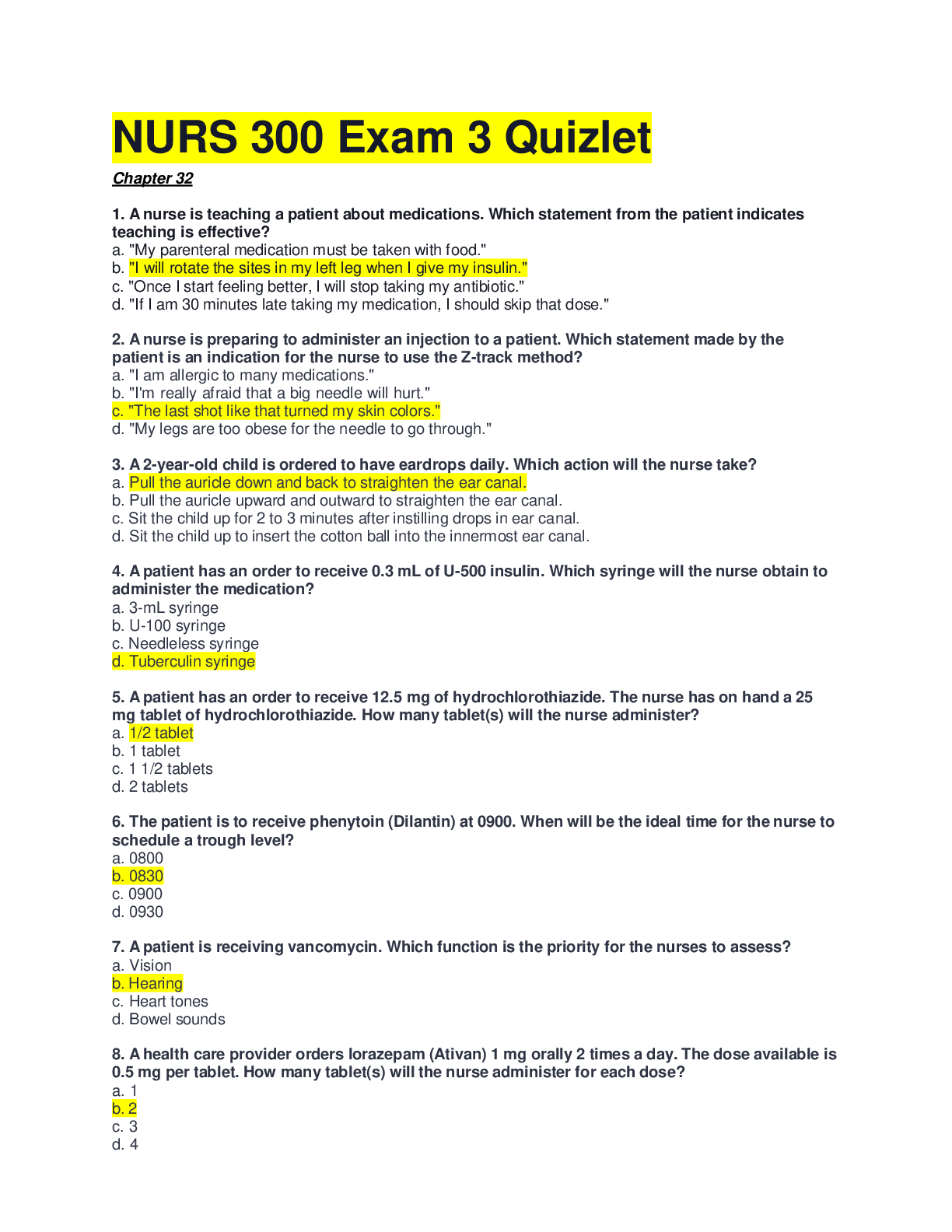
Buy this document to get the full access instantly
Instant Download Access after purchase
Add to cartInstant download
Reviews( 0 )
Document information
Connected school, study & course
About the document
Uploaded On
Apr 01, 2021
Number of pages
19
Written in
Additional information
This document has been written for:
Uploaded
Apr 01, 2021
Downloads
0
Views
83

.png)
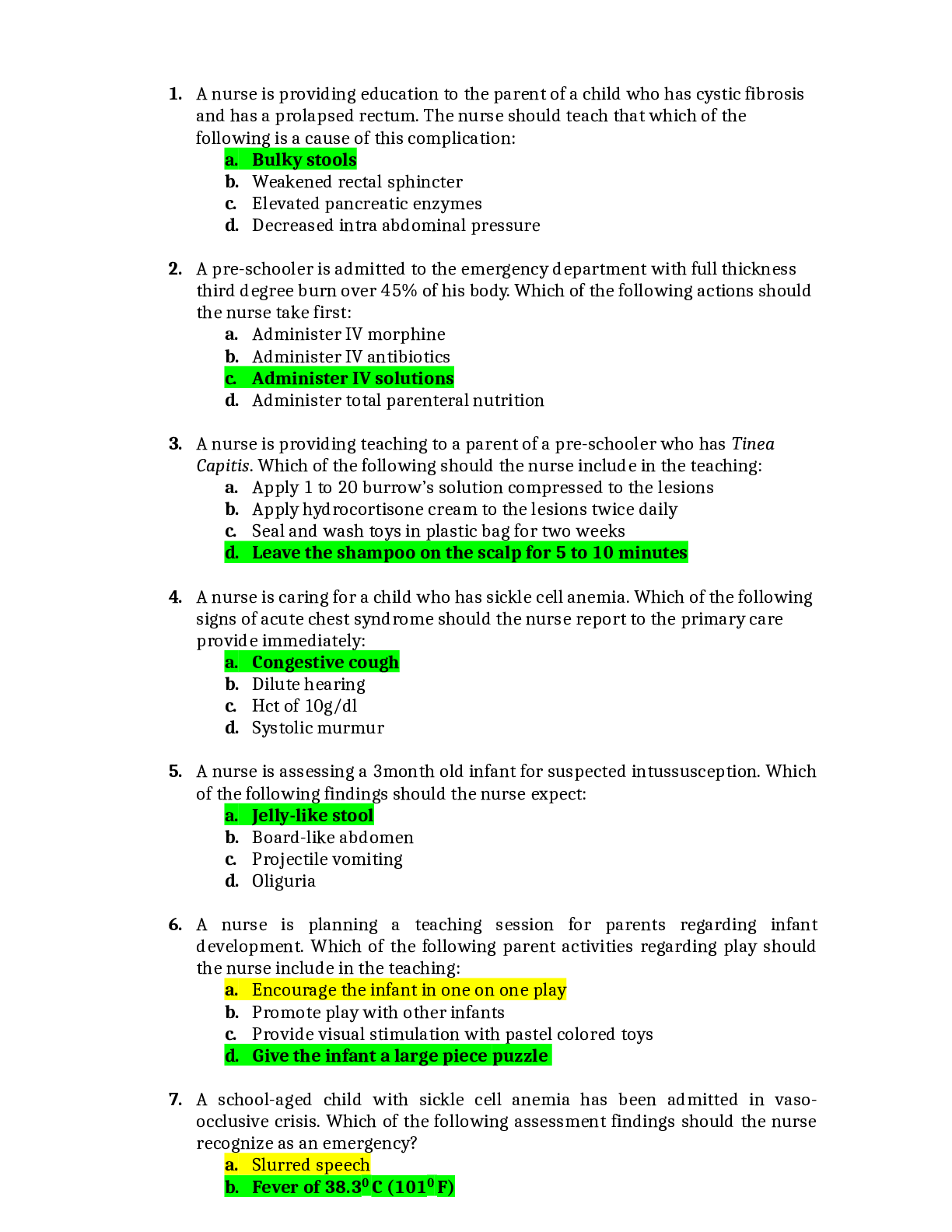


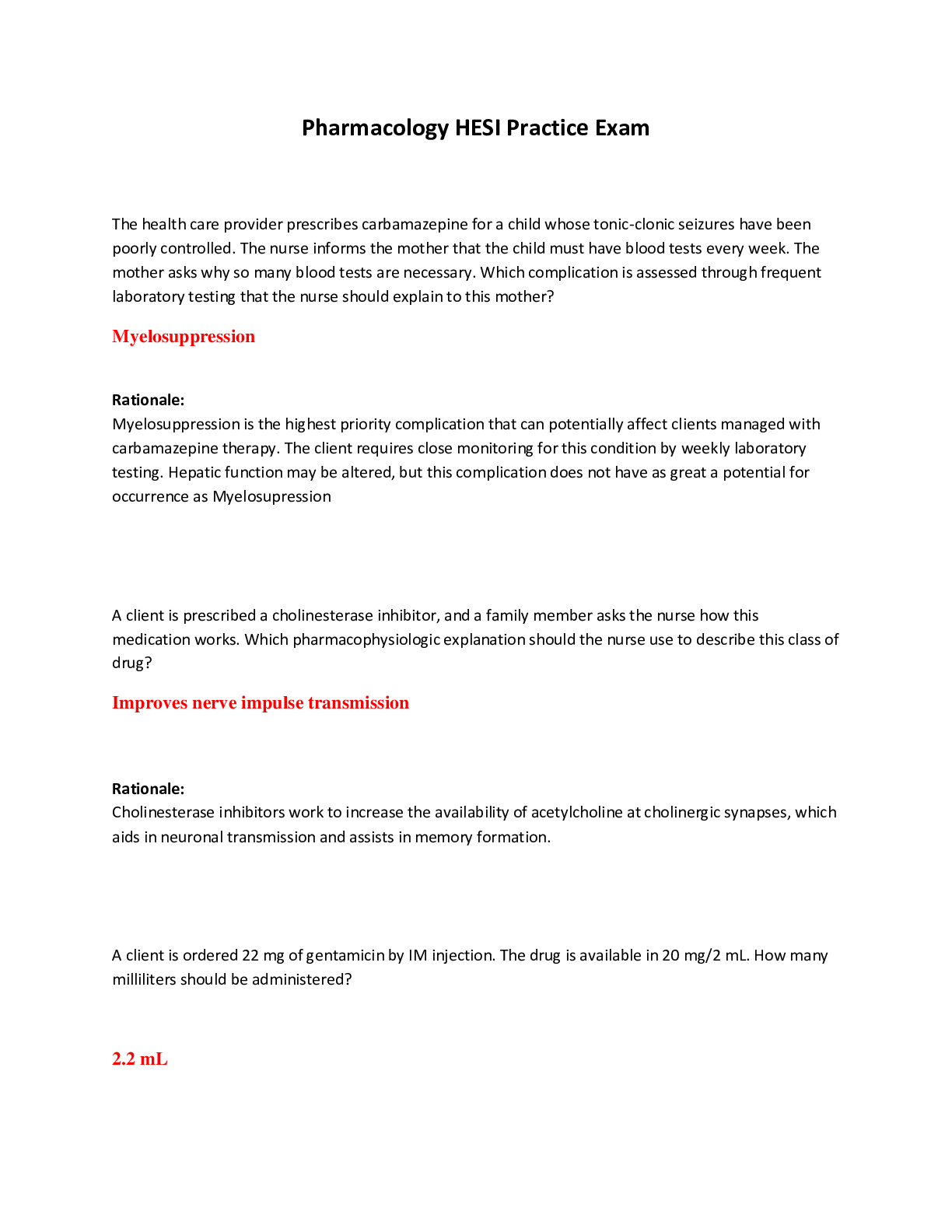


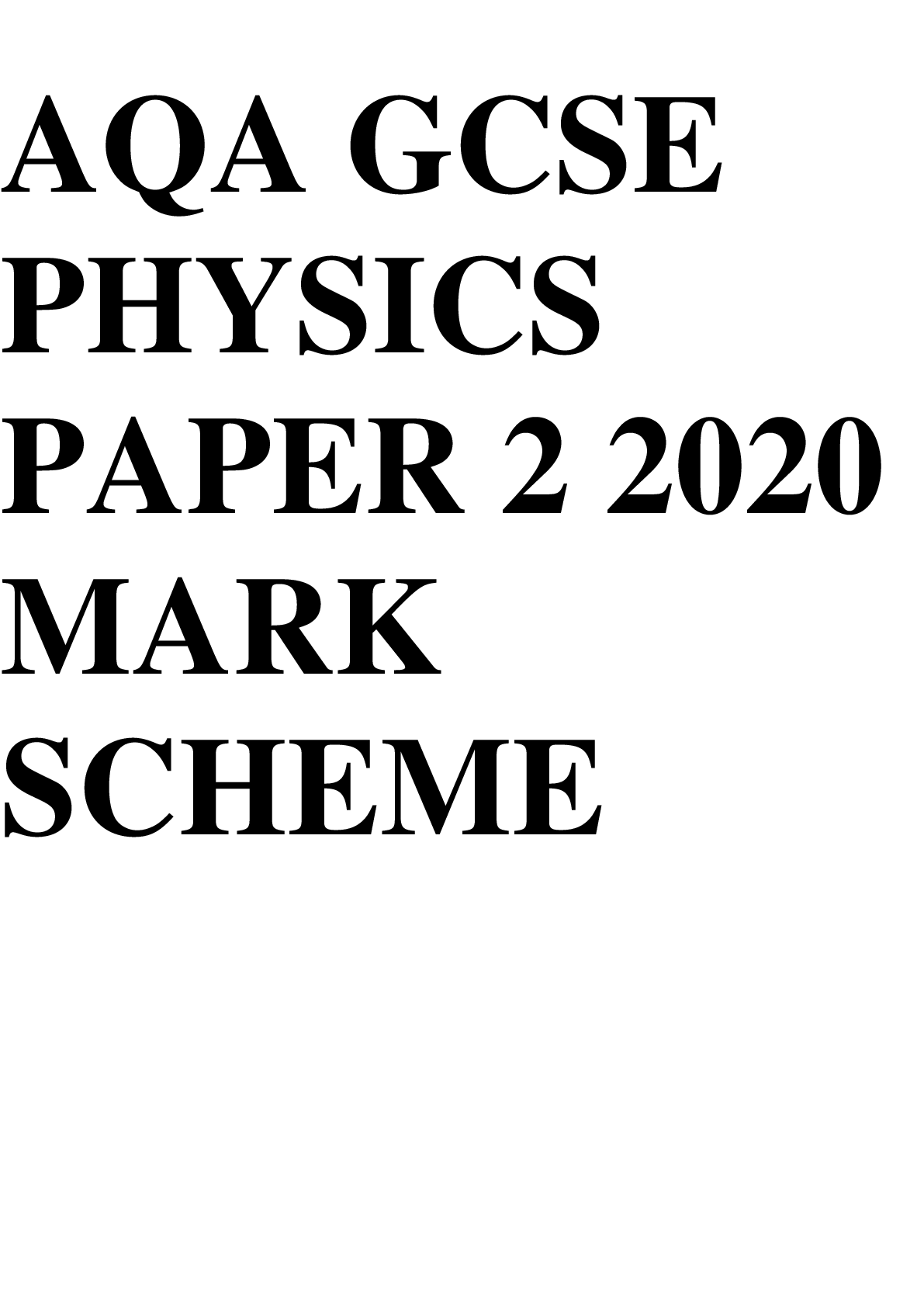


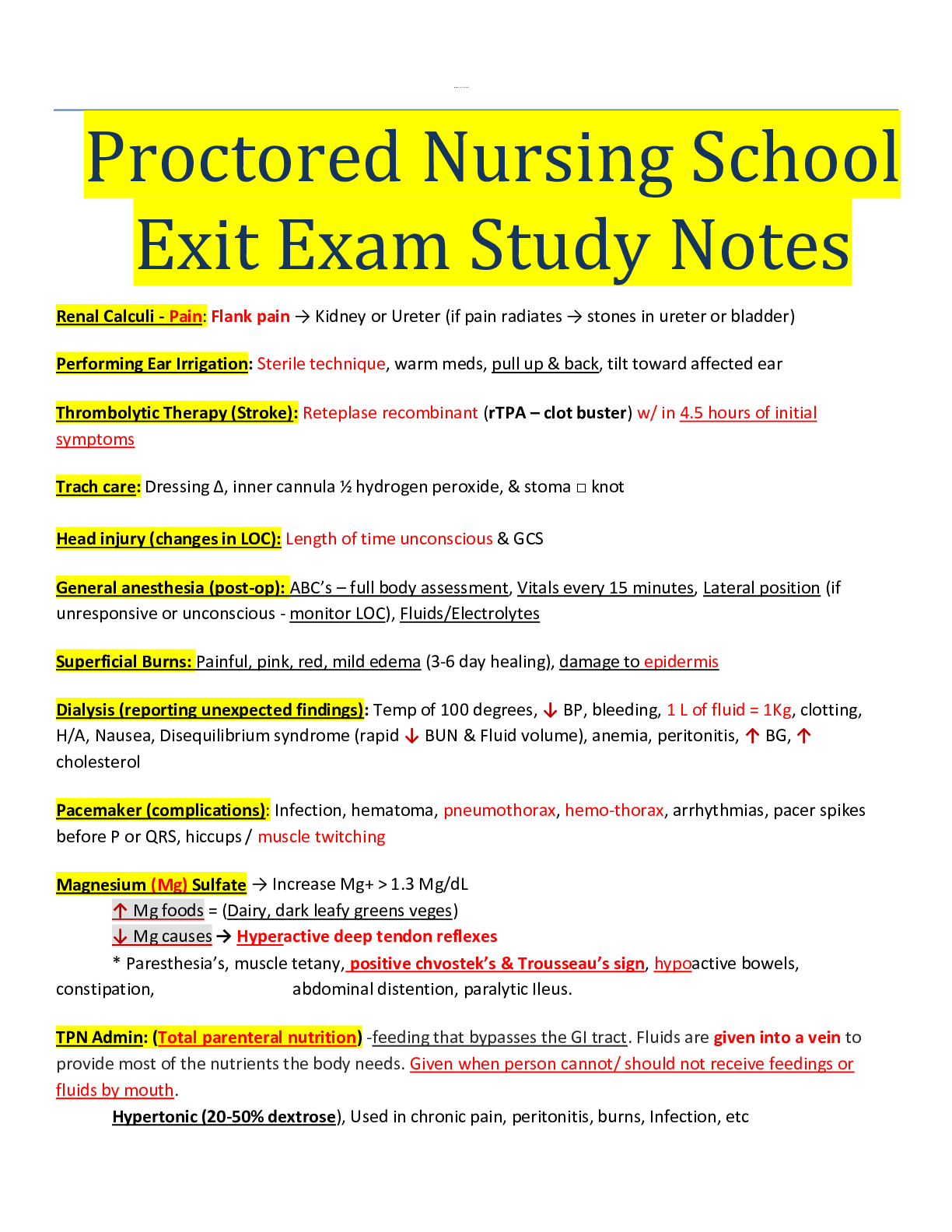


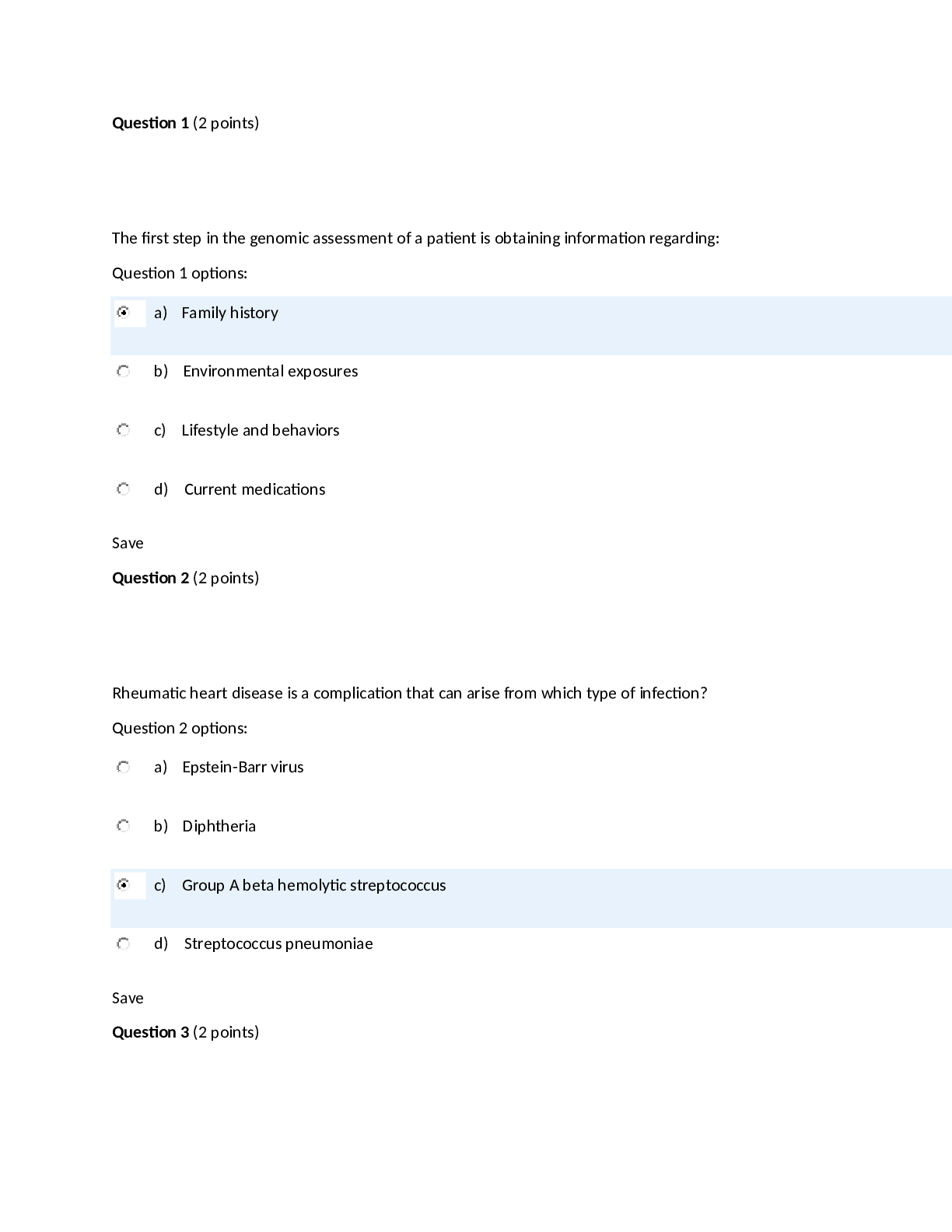
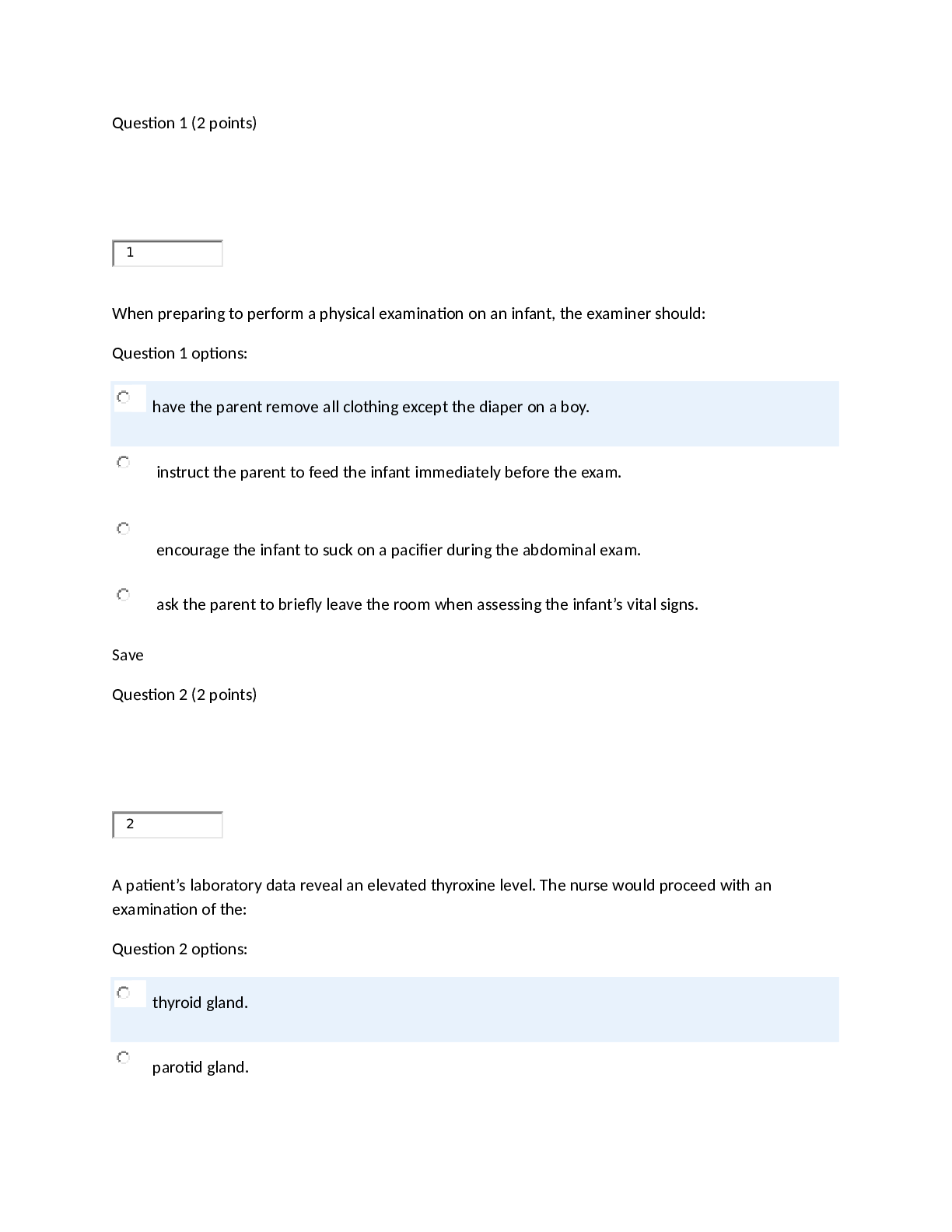
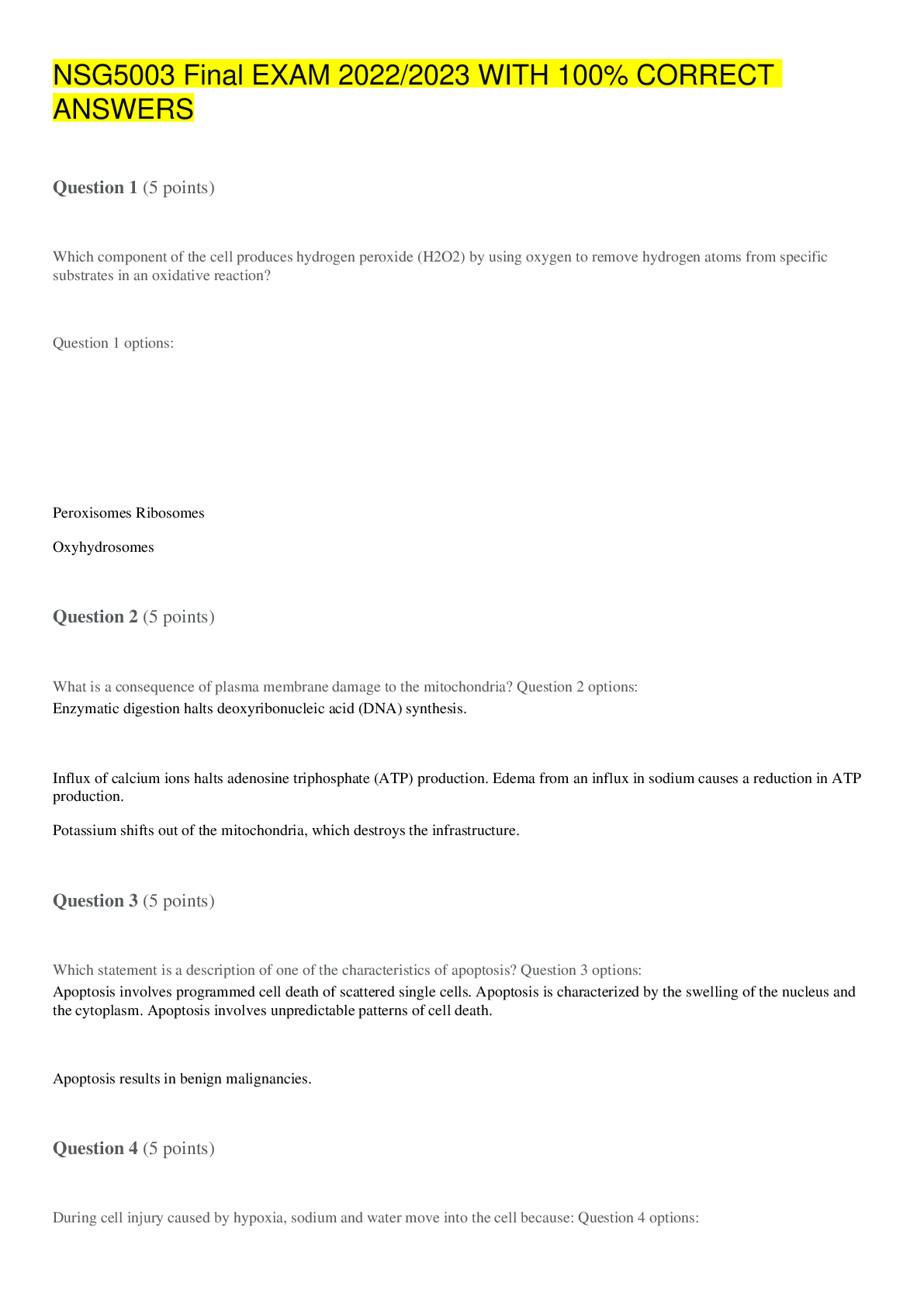

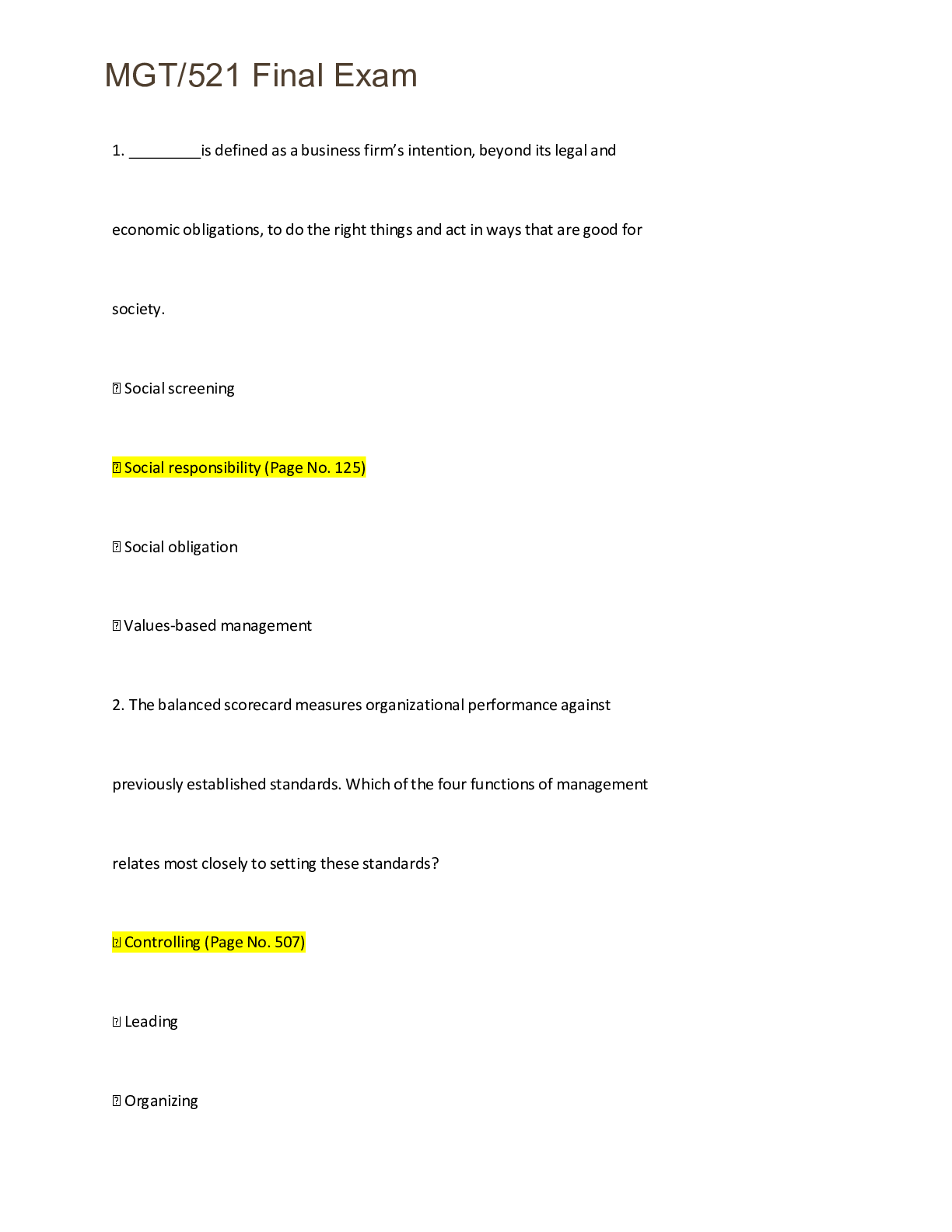
.png)
